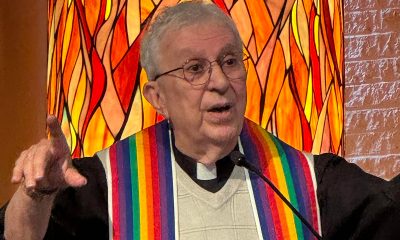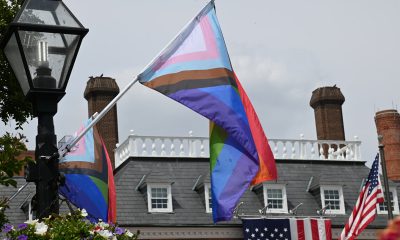Arts & Entertainment
Emily Saliers talks solo work in advance of Birchmere show
Longtime Indigo Girls’ singer/songwriter says time was right for groove-based album
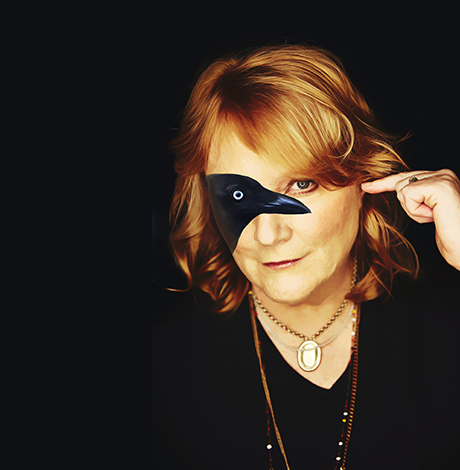
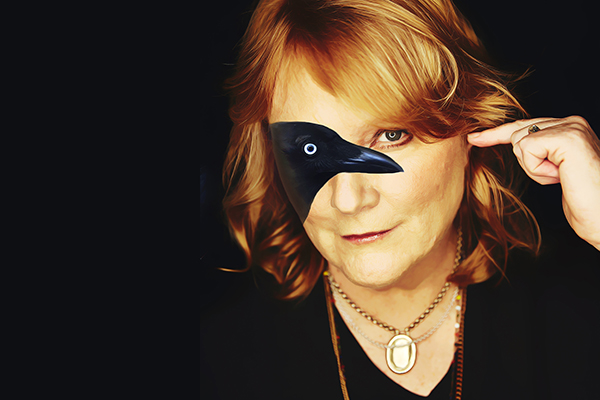
Emily Saliers is touring her debut solo album with a surprisingly elaborate band and stage show. (Photo by Jeremy Cowart)
Emily Saliers
‘Murmuration Nation Tour’
With Lucy Wainwright Roche
Wednesday, Oct. 11
The Birchmere
3701 Mount Vernon Ave.
Alexandria, Va.
$29.50
Thirty years and 14 studio albums into the Indigo Girls, Emily Saliers has released her first solo album, and even she acknowledges the artistic paradox.
“What’s a 53-year-old woman doing making her first solo record,” she says with a laugh. Although the Indigo Girls are alive and well — bandmate Amy Ray has released five solo albums and is working on a sixth — Saliers says it was a chance to pursue some of the more soul- and groove-oriented music she grew up with. “Murmuration Nation” came out in August. She’s touring it now and plays the Birchmere on Wednesday, Oct. 11. Her comments have been slightly edited for length.
WASHINGTON BLADE: How does it feel to finally have a solo album out?
EMILY SALIERS: Well, it’s great. I’ve been talking about it for a long time and even when I found (producer) Lyris Hung … it still took three years so it was like a real labor of love. … Sometimes you look at a CD and you think, “This is holding all that time and all that work and all that stuff,” and it’s a weird feeling but the response to the album so far has been overwhelmingly positive so I feel great about that.
BLADE: The Indigo Girls’ fan base is known to be highly loyal so is that a built-in audience for this or do you feel like you have to prove yourself somewhat?
SALIERS: I don’t have to prove myself. I just think the album is fairly different from anything Amy and I have done together in the same way that some of her records are very different from what we’ve done together. … I can’t just assume poeple will find out about it and get tickets to the show and stuff like that. … Without the Indigo Girls I wouldn’t have any solo record out … but still a lot of groundwork needs to get done to reach out and get people to listen to it.
BLADE: You talk about this being a more groove-oriented album. How hard is it to come up with a compelling groove or loop and which comes first — the music or the lyrics?
SALIERS: It’s not hard. … I could just pick up an Apple loop off my Logic program and just run that loop for five minutes and just start writing guitar parts to it and then a song gets born. A lot of the songs were written that way. They started with a loop or a beat and then that rhythmic pulse helped write the song. A few things that were written on guitar, Lyris said, “OK, we’re gonna take the guitar out of this and do this instead.” … I don’t sit down and go, “OK, I’m gonna write about guns in America right now.” I sit down and get a beat and find the chords and then the subject matter comes.
BLADE: Will you do some Indigo Girls songs on this tour too? You can’t really fill a whole show with just one album.
SALIERS: We’re gonna do mostly songs from the album. It’s a full band and a friend who’s a filmmaker has created some video images so it’s sort of a full sensory experience. A section of the show will probably be Indigo Girls songs that I’ve written, maybe acoustic, but we haven’t fully hammered that out yet. But the real purpose of the tour is to play the solo music.
BLADE: It feels like such a weird time in this country. You’ve been on the road some with Amy this year. Does it feel different at the shows or do people kinda wanna leave that at the door and just enjoy the concert?
SALIERS: It’s perceptibly different. From the first show we played after the election, it was palpable and there’s a real sense of anxiety among our fans but also a sense that we need music to galvanize us and to make us feel good. It’s a crazy fucking time in this country and not just a little — it’s a lot. It almost feels cosmic with the terrible storms, the earthquakes. We’ve been getting huge reactions to songs like “Pendulum Swinger” and “Rise of the Black Messiah.” … This country — it’s a bit of a tinderbox right now
BLADE: How much of your album was written by November?
SALIERS: All but one song. “Fly” was written in response to the election.
BLADE: When people yell out songs during the slightest lull in a concert, do you ever feel like saying, “Just chill — we have a set list?”
SALIERS: No. We try to honor as many of those as we can. We’ll look at the set list immediately and ascertain if there’s a spot where that song makes sense. Some we won’t do if they’re too rusty and we haven’t practiced them and sometimes we won’t do it if it’s something we’re tired of. Sometimes if we’re introducing something from our new album and somebody yells out, “Chickenman!,” we’ll say, “We’re gonna go ahead and do the one we were talking about.”
BLADE: The Indigo Girls were in our market in May for three shows with the NSO Pops. How did your symphonic shows come about and how were those dates?
SALIERS: D.C. was fantastic but after the third show, we were wiped because the symphony shows are the most intensive of all our performances. They’re one-offs, not typically tied to a tour, so we show up, meet the conductor, have a two-hour rehearsal and then we perform. You have to constantly be on your toes and it’s a different orchestra every time. The D.C. orchestra was phenomenal as you would expect. It got started because there’s an agency that puts artists together to arrange your songs and then you send the scores around and we got invited to do that and it’s been fantastic. … We’re doing a symphony album in 2018 that we recorded with the Colorado University Symphony so it’s become a very important part of what we do.
BLADE: Sometimes those arrangements for pop or rock acts are so lame and the orchestra is bored out of their minds. How do you feel yours turned out and was that a concern?
SALIERS: We worked with two different arrangers and then ended up sticking with this guy named Sean O’Laughlin and he’s just so creative and passionate. Amy and I both had long conversations with him about how he felt about the songs. … He put so much into them. … Often the conductor will say, “These are good arrangements, they’re interesting.” … We hired the right person.
BLADE: How many Indigo Girls songs do you have charts for now?
SALIERS: I think maybe 23. We usually do about 18 at one of those shows.
BLADE: The Indigo Girls have stayed fairly active in the studio while many other veteran acts just tour with nothing new out. Why is that important to you?
SALIERS: Yeah, I mean it’s true they’re expensive to make and nobody sells records anymore, even the type of top echelon of record-selling bands don’t really sell. We have to make a living touring, that’s just a reality, so it’s a good thing we love it and we never go out for too long. … We’re always excited to get back together and there’s always an internal push to create more new music. The only thing that keeps us from doing it more is busyness. … It just makes sense in the scope of a career to keep putting out new music.
BLADE: Do you think it’s lame with bands like the Dixie Chicks who just tour and tour and haven’t had anything new out in like 10 years?
SALIERS: Whatever anybody wants to do is fine. If people like it and they’re coming to your shows, I don’t really care. It’s just that for us, we know what keeps our fires burning and that is to create new music, to not be on the road all the time and to support each other’s independent projects. But whatever other bands want to do, I don’t have any judgement.
BLADE: How is your daughter?
SALIERS: She’s gonna be 5 at the end of November and she’s the light of my life. I never wanted to be a parent ’til I found the right person and it’s been a very happy marriage. We allow each other a lot of space and (wife) Tristin takes care of things when I go away and I take care of things when she’s involved in school or work. We love our kid and we have a really, really great life and I’m so grateful for it.
BLADE: You and Amy were so pioneering and were out when so few were in popular music. Have you ever had younger bands like maybe Tegan and Sara or whomever, tell you it was cool or inspiring that y’all were out so early?
SALIERS: I don’t recall that so much from other artists but we’ve had a lot of those conversations with fans. They’ll tell us personal stories about how the music carried them through a hard time when they were coming out or whatever and that’s really the most gratifying thing.
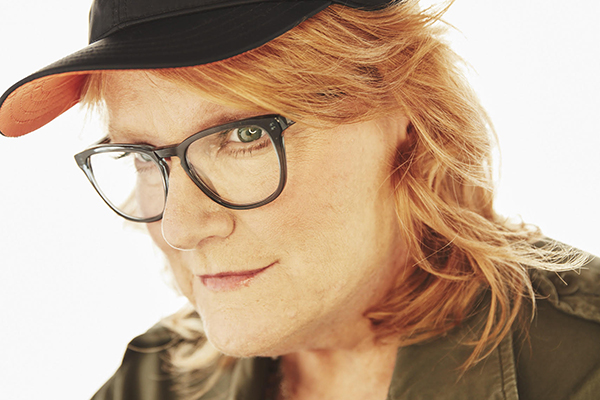
Books
Chronicling disastrous effects of ‘conversion therapy’
New book uncovers horror, unexpected humor of discredited practice
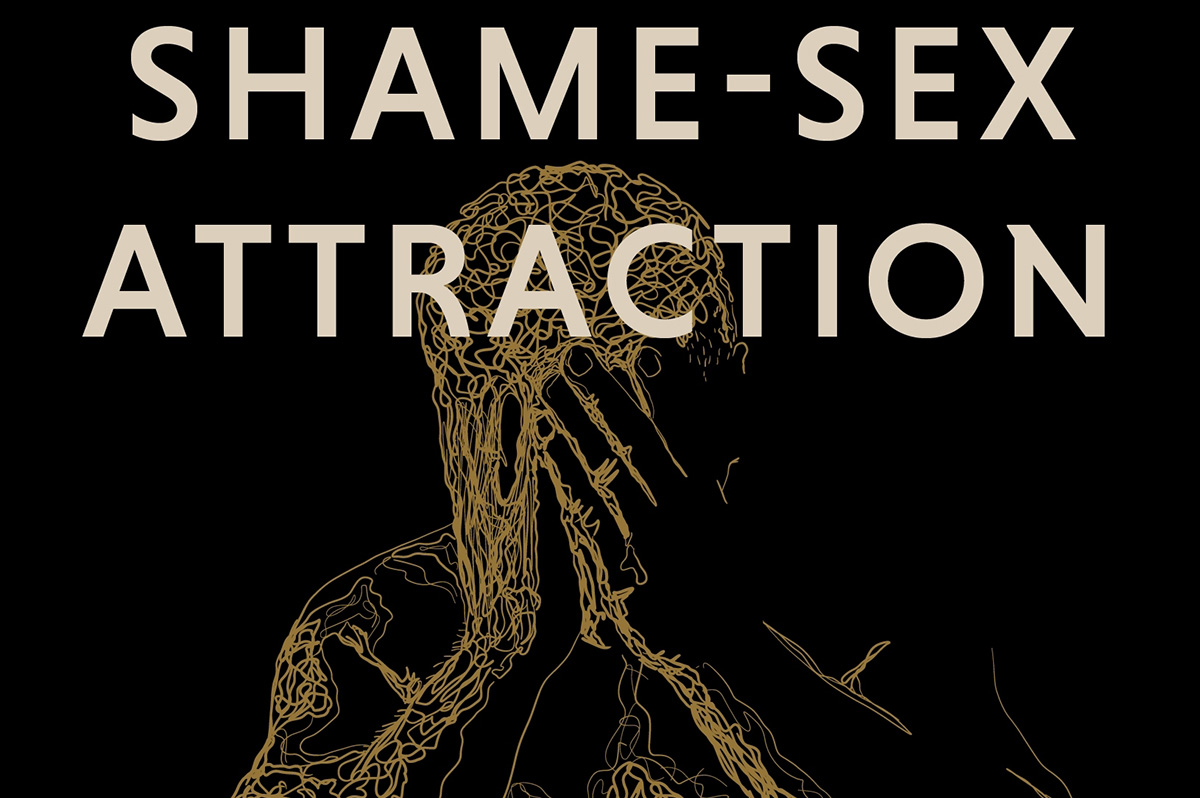
‘Shame-Sex Attraction: Survivors’ Stories of Conversion Therapy’
By Lucas F. W. Wilson
c.2025, Jessica Kingsley Publishers
$21.95/190 pages
You’re a few months in, and it hasn’t gotten any easier.
You made your New Year’s resolutions with forethought, purpose, and determination but after all this time, you still struggle, ugh. You’ve backslid. You’ve cheated because change is hard. It’s sometimes impossible. And in the new book, “Shame-Sex Attraction” by Lucas F. W. Wilson, it can be exceptionally traumatic.

Progress does not come without problems.
While it’s true that the LGBTQ community has been adversely affected by the current administration, there are still things to be happy about when it comes to civil rights and acceptance. Still, says Wilson, one “particularly slow-moving aspect… has been the fight against what is widely known as conversion therapy.”
Such practices, he says, “have numerous damaging, death-dealing, and no doubt disastrous consequences.” The stories he’s collected in this volume reflect that, but they also mirror confidence and strength in the face of detrimental treatment.
Writer Gregory Elsasser-Chavez was told to breathe in something repellent every time he thought about other men. He says, in the end, he decided not to “pray away the gay.” Instead, he quips, he’d “sniff it away.”
D. Apple became her “own conversation therapist” by exhausting herself with service to others as therapy. Peter Nunn’s father took him on a surprise trip, but the surprise was a conversion facility; Nunn’s father said if it didn’t work, he’d “get rid of” his 15-year-old son. Chaim Levin was forced to humiliate himself as part of his therapy.
Lexie Bean struggled to make a therapist understand that they didn’t want to be a man because they were “both.” Jordan Sullivan writes of the years it takes “to re-integrate and become whole” after conversion therapy. Chris Csabs writes that he “tried everything to find the root of my problem” but “nothing so far had worked.”
Says Syre Klenke of a group conversion session, “My heart shattered over and over as people tried to console and encourage each other…. I wonder if each of them is okay and still with us today.”
Here’s a bit of advice for reading “Shame-Sex Attraction”: dip into the first chapter, maybe the second, then go back and read the foreword and introduction, and resume.
The reason: author Lucas F. W. Wilson’s intro is deep and steep, full of footnotes and statistics, and if you’re not prepared or you didn’t come for the education, it might scare you away. No, the subtitle of this book is likely why you’d pick the book up so because that’s what you really wanted, indulge before backtracking.
You won’t be sorry; the first stories are bracing and they’ll steel you for the rest, for the emotion and the tears, the horror and the unexpected humor.
Be aware that there are triggers all over this book, especially if you’ve been subjected to anything like conversion therapy yourself. Remember, though, that the survivors are just that: survivors, and their strength is what makes this book worthwhile. Even so, though “Shame-Sex Attraction” is an essential read, that doesn’t make it any easier.
The Blade may receive commissions from qualifying purchases made via this post.
Arts & Entertainment
How queer Baltimore artists are building strong community spaces
Fruit Camp is home to tattoo artists, musicians, herbalist, and more

Fruit Camp, a tattoo and art studio in the Remington neighborhood of Baltimore, opened with a bang in February of 2020. “We had a big opening party. It was really fun. Everybody came,” says Geo Mccandlish, one of the co-founders. “It was the last rager I went to,” they said.
The pandemic shut down their shop—alongside the world—for months, but the shop survived. “We just put our stimulus checks into keeping the rent paid,” says Emi Lynn Holler, the other co-founder.
They had built the space without loans, on a low-budget, do-it-yourself ethos with hands-on help from their community. “The deeply punk shoestring budget background worked really to our advantage,” says Mccandlish.
While it wasn’t ideal, it was fitting. Mccandlish and Holler’s artistic partnership has almost always lived at the crossroads of community, DIY, and extraordinary circumstances. A decade ago they met as residents of the Bell Foundry, an arts co-op and co-living space, where sharing knowledge, making community, and living cheaply were key to getting by.
It was there that Holler gifted Mccandlish their first tattooing machine and taught them how to use it. And it was where the two of them—who also do printmaking, fiber arts, and other creative activities—started imagining co-founding a space of their own. That dream felt more urgent in 2016 when Baltimore condemned the Bell Foundry and evicted the residents, including Mccandlish, during a nationwide crackdown on artist co-ops after the Ghost Ship fire in Oakland.
Holler had by then moved to Massachusetts to pursue formal tattoo education and certifications.
“Living inside that level of precarity,” Mccandlish explains, “made us want to figure out a hybrid,” between the unique, collaborative Bell Foundry and a licensed, commercial space. “We wanted to find a way to create more safety,” says Holler.
But they didn’t just want to create safety for the two of them. When looking at spaces, they opted to lease a bigger studio—a two-story, double-row house with room for tattooing on the first floor and small studios on the second. Mccandlish said the prospect of a larger project felt “tantalizing and precious” because they felt “if you have access to something, you try to make sure that every resource that is a part of it is also shared.”
Today, in addition to tattoos, Fruit Camp holds studios for musicians, fiber artists, an herbalist, a massage therapist, and a doula. “We’re able to incubate and hold nontraditional pathways to different kinds of creative practices,” says Mccandlish.
You can consider Fruit Camp a queer business by several definitions. For one, every member of the studio identifies as queer, in some way. It also looks queer. “It’s campy and it’s pink, and we have a lot of gay art hanging around,” explains Mccandlish.
Holler says sometimes they get asked about losing potential patrons by being openly queer, but that isn’t a worry. “I think it only strengthens us,” they say. “It brings people to us who also want to find each other in that world.” They pause, “I feel like it boils down to we keep us safe and we take care of ourselves.”
Mccandlish emphasizes that “queer is the political meaning” and the “orientation to” which they do their work as a community space and business. Their shop practices are explicitly queer and trans-friendly—in addition to being “anti-racist, anti-sexist, liberation-oriented, and accessible.” For example, the shop requires masking and has consent-forward and trauma-informed practices in place. They also use cost-sharing instead of a traditional profit model with those who work in their space. “The point is not to make as much money as everybody can, the point is to work enough with a low enough cost overhead that everyone can survive without overworking.”
That is a continued goal, not a static place, they explain. “Some of our goals, we haven’t reached yet, like turning into a true worker co-op.”
But they are already making big strides in the community. For example, some patrons tell them that they are the only tattoo studio they feel safe using, due to the universal masking policies. To their knowledge, they are the only shop in Baltimore that has the policy.
Fruit Camp also has a big community name. One day Mccandlish logged onto a community Facebook group and saw an anonymous post asking about queer-friendly tattooers or tattooers who would tattoo someone who has HIV. The post said, “I’ve been turned away from five different shops.”
Immediately Mccandlish went to the comments to write that Fruit Camp would be happy to tattoo them, but instead, they found the comment section full of that recommendation already. It warmed their heart. “That feels like a very minor way that [our work] is so important.”
(This story is part of the Digital Equity Local Voices Fellowship lab through News is Out. The lab initiative is made possible with support from Comcast NBCUniversal.)
Theater
Timely comedy ‘Fake It’ focuses on Native American themes
Arena Stage production features two out actors

‘Fake It Until You Make It’
Through May 4
Arena Stage, 1101 Sixth St., S.W.
Tickets start at $59
Arenastage.org
A farce requires teamwork. And Larissa FastHorse’s “Fake It Until You Make It” now at Arena Stage is no exception.
The timely comedy focuses on Native American nonprofits fractiously housed in a shared space. Friction rises when rivals River (Amy Brenneman), a white woman operating in the Indigenous world, goes up against the more authentic Wynona (Shyla Lefner) to win a lucrative Native-funded grant.
While Brenneman (best known for TV’s Judging Amy) is undeniably a big draw, it takes a group collaboration to hit marks, land jokes, and pull off the well-executed physical comedy including all those carefully timed door slams.
As members of the six-person “Fake It” cast, Brandon Delsid and Eric Stanton Betts, both out actors of partly indigenous ancestry, contribute to the mayhem. Respectively, Delsid and Betts play Krys and Mark, a pair of two-spirited Native Americans who meet farcically cute and enjoy one of the play’s more satisfying arcs.
For Krys, every attractive man is a potential next fling, but when Mark, handsome and relatively reserved, arrives on the scene, it’s something entirely different.
Both onstage and sometimes off, Betts plays the straight man to Delsid’s waggishness. But when it comes down to real life business, the friends are on the same page: not only are the L.A.-based, up-and-coming actors intensely serious about their film and stage careers, but they’re also particularly engaged in the themes of Indigenous People found in “Fake It.”
On a recent Wednesday following a matinee and an audience talkback, they were ready for a phone interview.
In establishing whose voice was whose, Delsid clarified with “I’m the one who sounds a little like a Valley girl.”
WASHINGTON BLADE: Brandon, you’ve been with the show since its early work-shopping days in 2022 and through its debut in Los Angeles and now Washington. Have things evolved?
BRANDON DELSID: Definitely. I’ve grown up in the last couple of years and so has my character; it’s hard to know where I end and Kry begins. There’s been a real melding.
Eric and I are both queer, and to get to play these roles that are so human, imperfect, sexy, and interesting is really joyful.
As queer artists you don’t always get the chance to do work like this. So many stories are queer trauma, which is incredibly important, but it’s liberating to feel joy and ride it off into the sunset, which, without revealing too much, is kind of what we get to do.
BLADE: There’s some race shifting in “Fake It” particularly with regard to “pretendian” (a pejorative term describing a person who has falsely claimed Indigenous status).
ERIC STANTON BETTS: The last few years I’ve been on a journey with my cultural identity and place in the world. I’m a mixed BIPOC artist, my dad is Black and Native American by way of the Cherokee tribe and my mom is white.
Since 2020, I’ve tried to figure out where I belong in this cultural history that I haven’t had a tie to throughout my life; it’s gratifying to find my way back to my indigeneity and be welcomed.
In the play, race shifting is introduced through farce. But it’s never in a disrespectful way; it’s never mocked or done in a way to take away from others. The playwright parallels race shifting with gender fluidity.
DELSID: But in life, there are people posing as Indigenous, actively taking grants, and the play goes there, we don’t hold back. Larissa, our playwright, has made it clear that she’s not trying to figure it out for us. With that in mind, we hope people leave the theater interested and curious to learn more.
BLADE: Mark arrives kind of the middle of some crazy drama, bringing along a jolt of romance.
BETTS: Yeah, when I show up, we’re all sort of shot out of a cannon, struggling to keep up with the initial lie.
DESLID: A very gay cannon.
BLADE: What’s up next for you two?
BETTS: Both Brandon and I are up for the same part in a TV pilot, so one of us may be getting some very good news. I also have a Tyler Perry film coming out soon [he plays a model, not an unfamiliar gig for Betts].
DELSID: Coming up, I have a recurring part on HBO’s “The Rehearsal,” and a supporting part in “June and John,” a John Besson film. But doing “Fake It Until You Make It” in L.A. and now D.C. has been a special time in our lives. It’s 23/7 togetherness. There’s that hour for sleep.
-
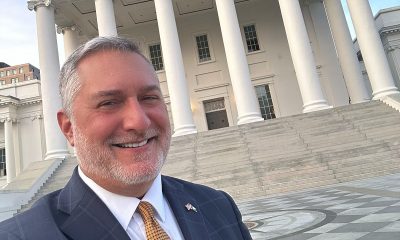
 Virginia3 days ago
Virginia3 days agoYoungkin calls on gay Va. GOP LG candidate to exit race over alleged ‘porn’ scandal
-
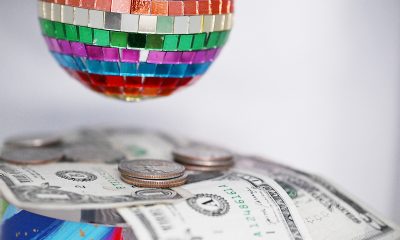
 Commentary5 days ago
Commentary5 days agoA conversation about queers and class
-

 Kenya5 days ago
Kenya5 days agoKenya Red Cross-owned hotel to host anti-LGBTQ conference
-

 Opinions4 days ago
Opinions4 days agoNavigating employer-sponsored health insurance, care

